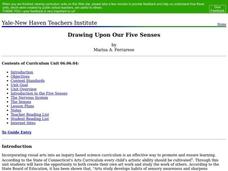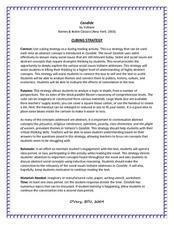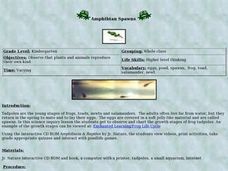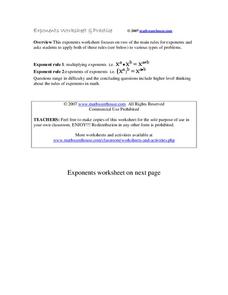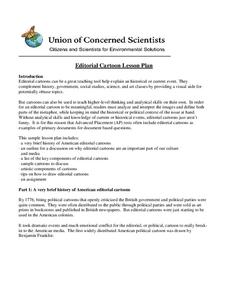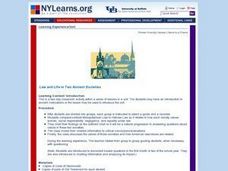Curated OER
Following the Lewis and Clark Trail
Fourth graders research the internet and fill out a worksheet about the expeditions of Lewis and Clark. In this Lewis and Clark lesson plan, 4th graders explore internet websites given to them in order to answer questions about the...
Curated OER
Drawing Upon Our Five Senses
Learners observe and create artistic representations, technological images, and scientific diagrams. They explore the five senses, the structure and function of the corresponding organs, and how the senses are connected to the human brain.
Curated OER
Drawing Upon Our Five Senses
Fifth graders identify the parts and functions of the body's five senses. In this biology lesson, 5th graders create a replica of the nervous system highlighting its parts. They create a scrapbook containing information on the senses...
Curated OER
Bioethics: Tool for Portfolio and Performance Assessment
Students, in cooperative studying groups, assume the affirmative or negative position of a particular issue (premise). They research the issue and participate in a debate. In addition, they write essays to complete a portfolio entry.
Curated OER
Railroad Idioms Art Lesson Plan
Sixth graders research railroad idioms. In this idiom lesson, 6th graders read through a glossary of different railroad idioms and their meanings. They illustrate a chosen idiom.
Curated OER
Choosing A Career - Without Limitations
Students examine their views on gender bias in the classroom. In this gender bias/gender equity instructional activity, students define non-traditional career areas for their gender. They discuss their perception of "male and female"...
Curated OER
The Gingerbread Person
Learners discuss gender bias and stereotyping. In this social science lesson plan, students read the book "The Gingerbread Boy" and discuss why it is a boy. Learners then write their own story changing it to a gingerbread girl and a...
Curated OER
Can We Switch Genders of Story Characters?
Young scholars read and review the main elements of a story. In this language arts lesson, students predict what the story read to them would have been like if the genders of the characters had been different. Young scholars...
Curated OER
Making Big Cats' Web Pages
Students investigate the lives of big cats by creating a website. In this web design lesson, students examine web authoring software in pairs as they read books on big cats. Students share their web page creations with the...
Curated OER
Designing a Web Page
Students utilize educational software to create their own websites. In this web design lesson plan, students collaborate in groups to create web page designs based on workers and figures from their community. Students...
Curated OER
Navajo Weaving
Students explore the Navajo culture. In this Navajo Indians lesson, students gain information about their weaving and dancing. Students note the patterns in the weaving. Students create a dance that corresponds with the patterns they see...
Curated OER
Candide Cubing Strategy
Candide is a dense text. To assist in analyzing Voltaire's satire, groups employ a cubing strategy based on Bloom's taxonomy. Complete directions for the strategy, a template for the cube, a worksheet, and a topic list are included.
Curated OER
Create a Board Game
Middle schoolers research, design, and create a game board based on information learned in ancient civilizations' social studies units. They utilize computer technology to research the project, as well as, textbooks, in-class library...
Curated OER
Big Cat Locations
First graders explore different environments while studying the habitats of big cats. In this big cats lesson plan, 1st graders draw pictures of their favorite cats, learn about the areas where cats live, design a zoo habitat and...
Curated OER
Amazing Animals
Students participate in an animal research report. They present a PowerPoint presentation to the class and follow specific instructions when it comes to what to include in the report.
Curated OER
Living With An Indian Tribe
Third graders research and compare differences between Navaho, Cheyenne and Kwakiutl Indian tribes, determine with which tribe they would choose to live, taking factors such as location and available resources into consideration, and...
Curated OER
Amphibian Spawns
Students observe tadpoles as they gradually change into adults. In this amphibian biology lesson, students watch tadpoles in a tank in the classroom, keep a daily record of what they observe, and chart the growth development of the...
Curated OER
Turn On, Tune In, and Write Down
Students locate, access and listen to a variety of radio and audio samples found on the Internet. They discuss the material in small groups and identify areas of interest for further discussion.
Curated OER
Exponents Worksheet
Students answers to 10 multiplication problems with same base and an exponent. They solve 10 exponent raised to an exponent problems. Students simplify six problems with a combination of the prior two types. Students determine the...
Curated OER
A Visit From The Jolly Postman
Students learn about the postal system and how mail is delivered. In this mail delivery lesson, students read The Jolly Postman: Or Other People's Letters and discuss the people and places the jolly postman would visit in their...
Curated OER
Editorial Cartoon Lesson Plan
Students consider the role of editorial cartoons on American politics. In this editorial cartoons instructional activity, students discover the history of the cartoons in America, analyze some cartoons, and then draw their own cartoons...
Kansas Poets
Persona Poem
Young poets are asked to craft a poem in the voice of a first person narrator, a dramatic monologue of sorts, that reveals not only a dramatic situation but something of the narrator's character as well.
Curated OER
Law and Life in Two Ancient Societies
Students work in groups and compare/contrast Mesopotamian Law to Hebrew Law. They chart their findings on a chart to show a natural progression to answering questions about values in these two societies.
Intel
Cell-to-Cell
The third in a series of 10 STEM project-based lessons focuses on cells types, functions, and physiology. Through research, discussions, writings, and presentations, groups learn about the difference between plant and animal cells, the...



